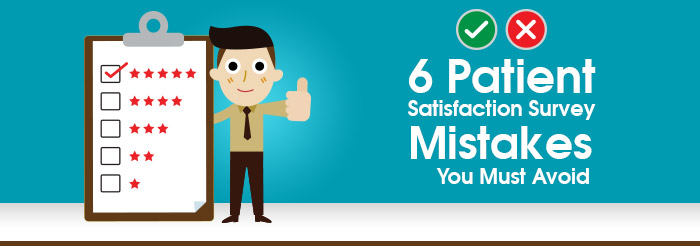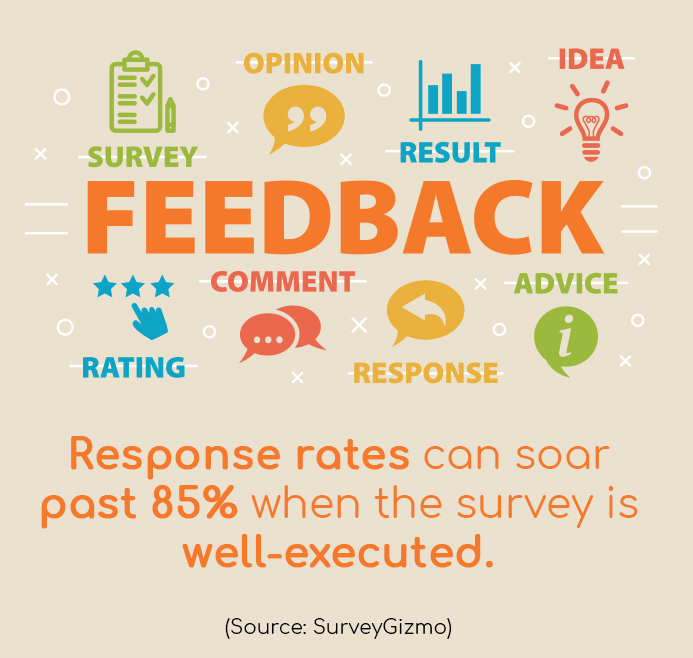6 Patient Satisfaction Survey Mistakes You Must Avoid
Posted on
If you are curious about your patients’ experiences and opinions about your medical practice, it is better to ask them yourself rather than waiting for them to tell you or post a review on a public online platform, which may be negative and end up damaging your reputation.
The perfect way to gauge patient satisfaction in a way that is both private and actionable is by sending out a satisfaction survey. These surveys are simple for your patients to fill out and can be analyzed to help you gain valuable insights about your patients’ experiences.
Why do you need a patient satisfaction survey?
Patient satisfaction surveys track how delighted your patients are by your practice or a certain experience with your practice. Based on these results, you can measure the satisfaction score, which determines a patient’s satisfaction with your practice, typically on a scale of 1-10.


Analyzing responses to questions can help you calculate how the concept of patient satisfaction has changed over time and how you can introduce changes in order to improve the patient experience.
However, formatting patient surveys is one of the most challenging parts. There are a lot of common mistakes that most healthcare marketers make, and those mistakes can make your results oscillate. You can make sure your survey will be accurate and effective by avoiding the following common patient satisfaction survey mistakes:
1. Asking too many questions
In their efforts to obtain detailed and in-depth feedback, most healthcare marketers tend to go overboard and ask too many questions. While it is important to get complete and honest feedback on all aspects of your practice, it is equally important to include only the necessary questions. This is because if you ask too many questions, participants may get bored and drop out of the survey before it is complete.
Or worse, participants might start answering randomly in a bid to complete the survey, resulting in inaccurate outcomes.
The key here is to prioritize your questions and focus on areas that you think need improvement. Keep your surveys short and simple. If the survey cannot be completed in a few minutes, it is too long.

2. Asking the wrong questions
A majority of surveys finish with a text box that allows participants to add comments or opinions they may have.
This part often takes this form: “Do you have anything else to add? Your feedback will help us improve.”
These types of questions are too broad and, unless the participant has any burning issues, are often left unanswered. It will be more effective to ask important questions that will get people thinking. A better question to end a survey would be: “If you could change one thing about our practice, what would that be and why?”
3. Avoiding tough questions
We do not like to be criticized. So it is tempting to keep questions lightweight and biased toward responses that we would like to see. However, if you are really committed to improving your service, you will need to get to the heart of the problems and understand the challenges. It might be an uncomfortable process, but it is the only way of moving forward and bringing about a noticeable change.

A typical unbiased question would be: “Did you feel that your visit was worthwhile and that we attended to you properly?”
A much more valuable but tougher question would be: “What was it that nearly made you leave before your appointment?”
It is brutal, but it will definitely wheedle out a correct response. If the participant senses that you really are looking for an honest reply, he or she will be much more likely to give it.
4. Asking too many closed questions
A majority of patient satisfaction surveys are entirely made up of yes/no questions. While these are useful in that they allow the participant to answer a large number of questions quickly, they also make the analysis pretty straightforward.
However, asking too many yes/no questions can end up with a bland survey that may not give you a substantial outcome.
Make sure your surveys give ample opportunities to participants for writing a freehand response to your questions. Unprompted insights will be the most useful.

5. Not telling patients how long the survey might take
Just like your own, your patients’ time is valuable too. Make sure you let participants know how long your survey might take before the patients get started. This will allow participants to adequately prepare for the survey. Informing them beforehand is important because where a five-minute survey can be taken without thinking twice, patients might need to block out some time to focus on anything that takes longer than 10 minutes.
With that said, shorter is better when it comes to patient satisfaction surveys. Patients might be willing to complete short surveys for free, but anything longer than 10 mins may require some kind of reward to entice them.
6. Surveying too often
If you bring up patient surveys on social networks, somebody is likely to complain about the length of the survey or survey fatigue. Most of the participants complain that their inboxes are filled with surveys from many different medical practices, each wanting their time. One of the best ways to avoid stressing your patients is not to survey them often.
Sampling your patients will help you avoid surveying a patient who was recently surveyed. A patient satisfaction survey is statistically based, and therefore you do not need to do a census of every patient in order to get valuable data. A good sample of a subsection of your patients will give you a fairly accurate idea of how you are performing. We would recommend surveying patients no more than once every eight to ten months.

Conclusion
In order to make your medical practice the best it can be, you need to listen to patients. Learn from your mistakes and look for patterns and issues that need to be addressed immediately. Create a unified force in your practice to tackle issues at hand and work together for improving the patient experience. Take the time to craft a professional and polite response that aims to address the problem areas. Finally, and most importantly, do not dwell on the negative aspects highlighted in the surveys. Learn from them, acknowledge the mistakes, accept the problem, and work toward a resolution.

 What Is YMYL and What It's Impact on Healthcare SE..
What Is YMYL and What It's Impact on Healthcare SE.. 7 Christmas Social Media Post Ideas for Hospitals ..
7 Christmas Social Media Post Ideas for Hospitals .. How to Create a Winning Healthcare Marketing Strat..
How to Create a Winning Healthcare Marketing Strat..